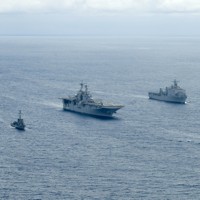U.S. Defense Secretary Leon Panetta made news this weekend when he announced that the U.S. Navy would move the bulk of its fleet to the Pacific in coming years as part of the Obama administration’s military rebalancing program. But the declaration should have come as no surprise, as the Pentagon has been increasing the share of its assets in the Pacific for several years already.
Panetta was attending the 11th International Institute of Strategic Studies (IISS) Asia Security Summit, widely known as the Shangri-La Dialogue, in Singapore. In his speech, Panetta emphasized that the United States, after a decade of focusing on the wars in Afghanistan and Iraq, would now concentrate more forces in the Asia-Pacific region.
Earlier this year, Panetta laid out the new Pentagon strategy, which, while reducing U.S. forces in the Middle East and Europe, would sustain and perhaps even increase U.S. military power in East Asia. The only novelty in his Singapore speech was in the precise ship numbers. The Navy now has an equal number of its 285 cruisers, destroyers, littoral combat ships and submarines in the Atlantic and Pacific. Panetta said that, at the end of this decade, some 60 percent of the fleet would be in the Pacific.

